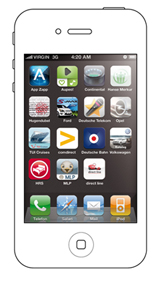There’s no doubt that apps remain the hot topic. The big question now though is what type of app are we talking about? More importantly, what type of app should we be considering as solutions for our clients? Is it a native app, hybrid app, web app or generic mobile app? Distinguishing what the client, and ultimately their customer, really wants is the great skill here. One size does not fit all.
Users are undoubtedly transitioning away from the desktop to mobile (smartphones and tablets) and are searching the mobile web or app stores to find their desired content. Not being present on either can have a drastic impact on engagement or visitor numbers with both potential and existing customers.
So what’s the key to a successful app?
So much of this depends on the type of app being developed. Is this B2B, B2C or enterprise-related? For the first two, it has to have a strong marketing focus behind it to even register with the consumer.
With some 10,000 apps being released daily, you’ll simply sink without a trace if you have no thought process to exactly how your app is going to get noticed or picked up. If you’re successful enough to get past that first hurdle (many won’t!), then you need to ensure the app brings value to the end user in either content or functionality.
It has to do something useful, like providing location-based information, for instance. Delivering bog-standard brochure content which is readily available on your website will likely see your app deleted 60 seconds after it being installed.
What things do you avoid/consider when creating an app?
Wow, there are so many things to avoid when creating apps and, again, this really depends on which market you’re targeting. If you’re going to look to advertising as a revenue stream via your app, that’s fine, but make sure those ads aren’t intrusive or annoying. You’ll know yourself from others you’ve used that if an ad is popping up every 90 seconds, you can pretty much guarantee negative reviews. You simply won’t generate the levels of revenue you intended to with an over-eager ad frequency policy.
Also, and this is pretty common sense, but remains something people still don’t give enough time to…Make sure the app actually works! Ensure it is stable and doesn’t crash every time the user opens it up. Test, test and test again. Experience tells us that people will persevere with apps from giants like Facebook that may have a few issues initially. Unfortunately, most of us don’t have the luxury of being Facebook so ensure your app works first time, every time. You’ll rarely get a second chance before the end user deletes it.
Design the app specific to the device for what it is intended. You aren’t on a desktop and space is at a premium, so users want intuitive, easy-to-use interfaces. They’ll soon get frustrated with constant pinching and zooming to get to a text box to a readable size on a form. Things like this really should be on the web and not in a mobile app. Nobody really wants to form fill, but accept it as a necessary evil. Why make that process even more difficult?
Are we ready for HTML5 yet?
HTML5 is starting to prove its worth on the mobile platforms where it essentially has ubiquitous support. Well-built hybrid and web apps are making great use of HTML 5 to deliver cross-platform apps.
However, I’m not sure the same can be said for the web. Until those in the corporate and wider consumer world have the latest generation of browsers installed, progress of HTML 5 on the web will be much slower than in the mobile space. Ageing browsers, like IE6, unfortunately remain a widespread choice, so that has to change before HTML5 takes any serious effect in the web space.
What about apps and advertising?
Mobile advertising is growing. A number of studies in the last year showed a doubling of ad spend year-on-year and the demographic of users who are ‘plugged in’ to using mobile very much engage with mobile ads, especially for purchasing of digital goods such as eBooks and other apps. Remember though, this is a savvy audience. It goes back to that intrusion and frequency discussed earlier. Get this wrong and no amount of styling and usability will save your app from the dreaded delete button.






